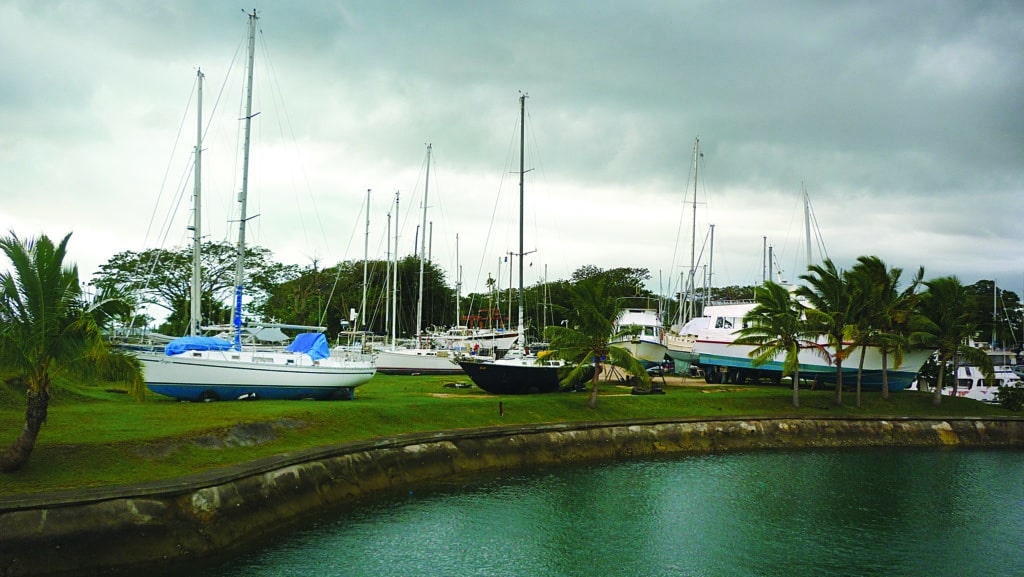
If you sail long enough, you’ll likely leave your boat in a foreign country either to travel or to sit out a storm season. Most of us prefer palm trees to parkas, so chances are it will be in the tropics. Surprisingly, however, when leaving your vessel stowed securely in a known storm area, a tropical cyclone is probably not the greatest threat. An unprepared boat stored in a hot, humid climate can be a breeding ground for two other forces, small but mighty, that can quickly overcome an unattended vessel: Quiet and extremely invasive, mold and insects can often wreak more havoc than a storm.
My partner, Steve, and I have left our Newport 41, Kate, on the hard in Fiji four times during the South Pacific cyclone season. She’s endured weeks of monsoon rains, months of glaring tropical sun, and a Category 4 storm. Each time we’ve returned, it was on a long-haul, red-eye flight, and after a few hours of airing her out and unpacking, we’ve been able to sleep on board that evening.
Salt Is Your Enemy
On a boat, you’re constantly surrounded by salt; it is in the water you float on and the breeze you sail in. It even leaks out of your body when you sweat. Salt attracts moisture, leaving clothes and cushions feeling perpetually clammy, and surfaces greasy. Moisture encourages the growth of mold and mildew, especially in hot, humid environments.
The most important thing you can do for your boat is to make sure everything is properly cleaned and dried before packing it all away. And I mean absolutely everything — every piece of equipment and every storage compartment, every item and bit of gear you regularly use. It’s time-consuming, but by eliminating salt residue, the chances of mold and mildew taking over while you’re away are drastically reduced.
Clear the Decks
Leaving sails furled or covered on the boom in the sun will shorten their life span, and no matter how well tied, they can come free in hurricane-force winds, ripping themselves to shreds and possibly damaging the rig.
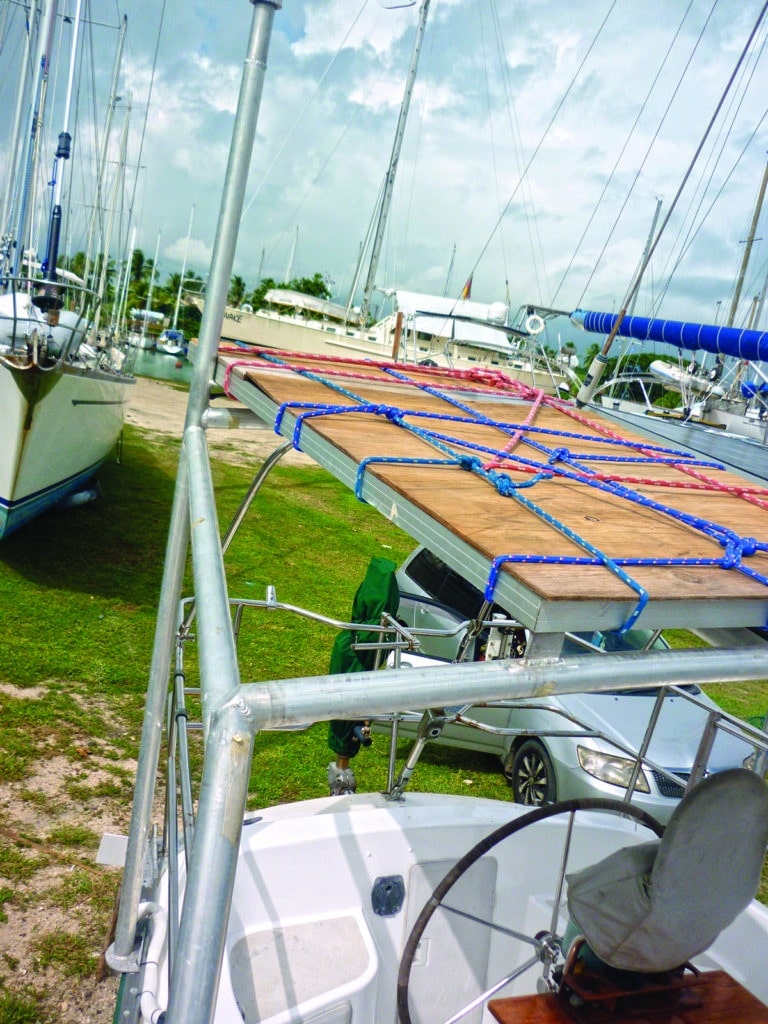
To prevent mold, pick a windless morning to hoist sails and give them a good soak with a hose. Wind permitting, it’s easiest to leave sails hanging to dry, but you can also find a nice patch of grass and lay them flat on the ground. Just remember to flip them, and allow extra time for the thick, reinforced panels and UV strips to dry.
While you’re waiting for sails to dry, check stress points at the tack, clew and headboard. Look over hardware and batten pockets, and inspect stitching and any previous repairs for signs of damage. The off-season is a great time to get any repairs, modifications or maintenance done to your sails. The local sailmaker will appreciate having lots of time to complete the work, and might also have facilities for sail storage in the loft.
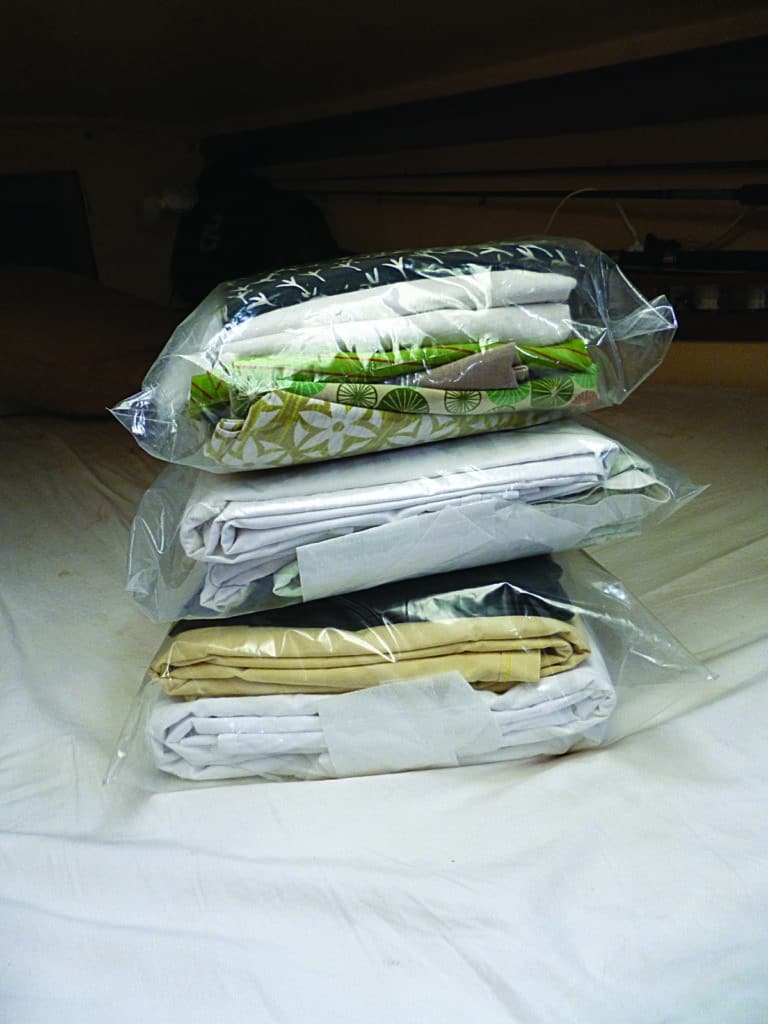
Don’t forget about the spinnaker, storm sail, code zero, and other light-wind or heavy-weather sails. If they have been sitting unused for a while, they will benefit from a good airing and general inspection.
Now that the sails are down, it’s time to think about the running rigging. Tropical sun is harsh, and cordage left exposed and unused for months can quickly degrade. Take the extra steps to remove as much running rigging as possible; it’s the best way to preserve your lines and your wallet.
Once removed, lines should be washed with plenty of fresh water, and any rope used for dirty jobs such as ground tackle should be scrubbed until clean. To condition lines, try soaking them with a dash of Woolite detergent. I find it keeps lines supple without making them feel slippery. When you’re through, coil lines and leave them hanging with good air circulation for a day or two before stowing, to ensure they are thoroughly dry. This is a good opportunity to inspect halyards for chafe and breakage, and to make note of any that need replacing.
Even if your sheets and halyards are color-coded, that doesn’t mean you’ll remember what is what when you dig them out of storage when you return. It takes only a second to snap a few pictures of your setup and label each coil with a piece of tape before you start to remove lines. You’ll be happy for the little reminders when it comes time to re-rig the boat in a few months — believe me.
Dorade vents and solar-powered fans are a great way to circulate air through your boat while you’re gone, but they are also wide-open doors for bugs. If you plan on leaving them installed, cover them with a piece of fine mesh or fly screen to keep insects out. Make sure it is well-fastened so it doesn’t blow away, and remember that even duct tape will lose its stick after a few months out in the elements.
The last things to be removed are usually the bimini, dodger and other sun covers, as they still provide much-needed shade as you work to dismantle everything. Make sure you tie down any remaining bows and supports for your canvas. Although we have left some tarps up while away, to keep the birds from making a mess of the decks, we always make arrangements with the marina to have them taken down in the event of heavy weather so they don’t cause damage. Also keep in mind that industrious birds like the myna will make short work of moving into places like the open end of the boom or a fold of material while you’re gone. Plug and tape any gaps or crevices that could be potential nesting sites once the sails and rigging are removed.
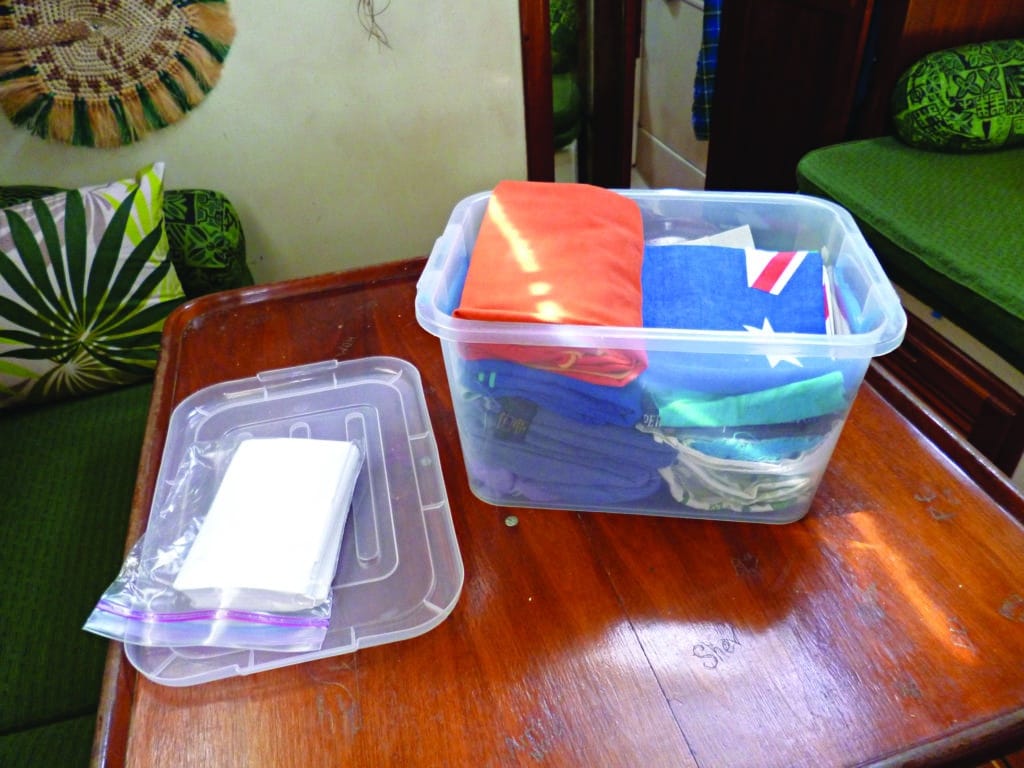
Clean As a Whistle
I once read that after the mast, the galley stove is the most used piece of equipment on board. Even if you’re a meticulous cook, there will be food particles and spillage in hard-to-reach places — a virtual buffet for bugs. The more thorough you are in cleaning the galley, the better.
With careful planning and some creative cooking, there should be very little unused foodstuffs at the end of a season. Anything left over should be discarded. Wheat products such as flour, pasta and cereal are prone to weevils, so it is best to throw out or give away any unopened packages, rather than risk a hard-to-get-rid-of infestation. It’s not worth keeping any opened jars — especially sweets like honey, molasses and jam — as they will only attract pests. Inspect all unopened bottles and cans, making sure jars are sealed properly and cans are not showing signs of rust. If anything looks suspect, get rid of it. With everything emptied, it’s time to clean all storage containers, dishes, cutlery, pots, pans, cupboards and holds.
I normally dislike using spray-type insect repellents near food-prep areas, as there is a high possibility of food contamination. However, with all foodstuffs discarded and the galley sitting unused for several months, this is a good time to use a long-lasting surface spray in storage compartments and near any holes where wiring might run.
Give yourself enough time to thoroughly defrost fridges and freezers. Do not attempt to remove ice from the freezer with any kind of sharp object; you’re likely to cause more damage to your freezer plates than the ice. Instead, place a bowl of boiling water inside the unit; the steam will melt the ice without harming the fridge. White vinegar is a natural deodorizer and great when used to wipe down the inside of reefer units. For stubborn smells like fish, wipe with inexpensive vanilla extract after cleaning.
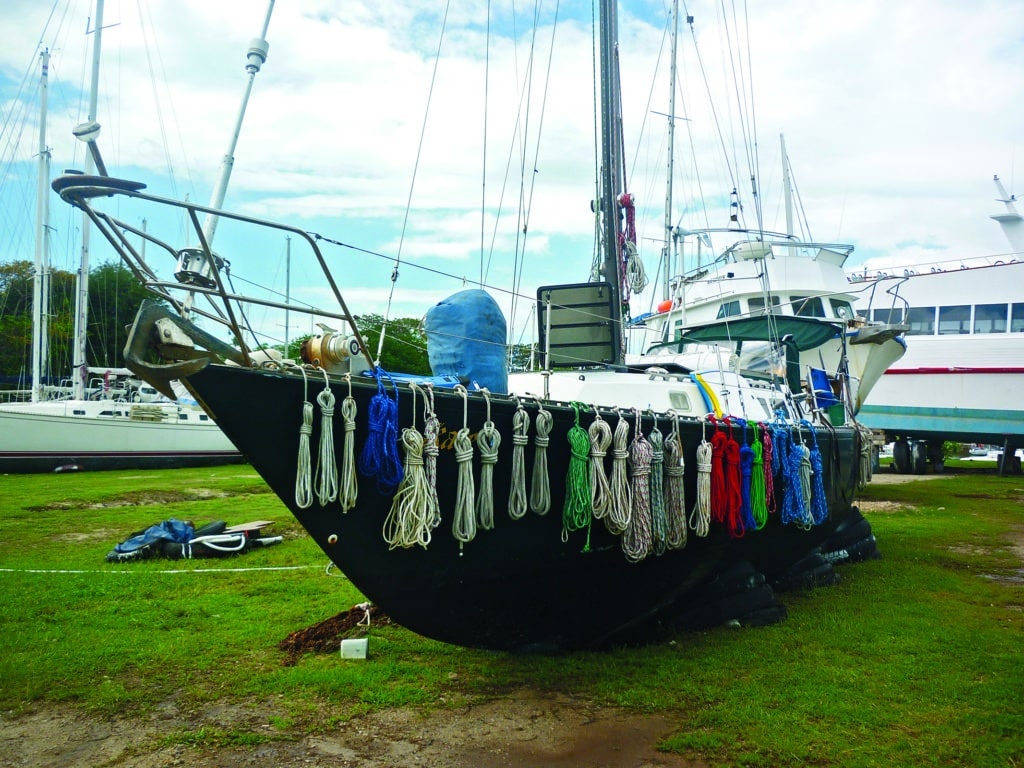
Packing Up
By now you’ve probably dug out the suitcases and started packing, so it’s a great time to reach to the back of the hanging closet to check for leaks and to pare down the wardrobe. Clothes and towels that are used regularly throughout the season deserve a good washing, and items that have been in storage, such as bed linens, should be aired to ensure they’re dry. I use large zipper bags and airtight plastic containers to store clothes, towels and linens, and cover anything left in hanging compartments with plastic garbage bags in case of leaks from above. To absorb moisture and keep things fresh, add a couple of dryer sheets to each bag or container; even after months in storage, the contents will smell line-dried and be ready to use.
We live in a digital age, but any sailor who likes to read probably still keeps a stash of paperbacks on board to read on passage. Then there are the cruising guides, cookbooks, equipment manuals and paper charts that we all depend on. I have stored books and other paper products in airtight plastic totes for up to a year on board with no signs of must or mildew. Make sure items are dry before storing, and add a couple of dryer sheets, mothballs or cedar chips to absorb moisture and deter bugs. Charts can be stored flat in oversize zipper bags or in plastic chart tubes available at some chandleries and nautical bookstores.
I always air out all the cushions and mattresses on board and remove the covers for washing at the end of the season. This is especially important for cockpit cushions, to rinse away the salt and prevent mildew from ruining your upholstery. Sunbrella fabrics should be hand-washed and can be treated once clean and dry to preserve their water resistance; check the manufacturer’s suggestions.
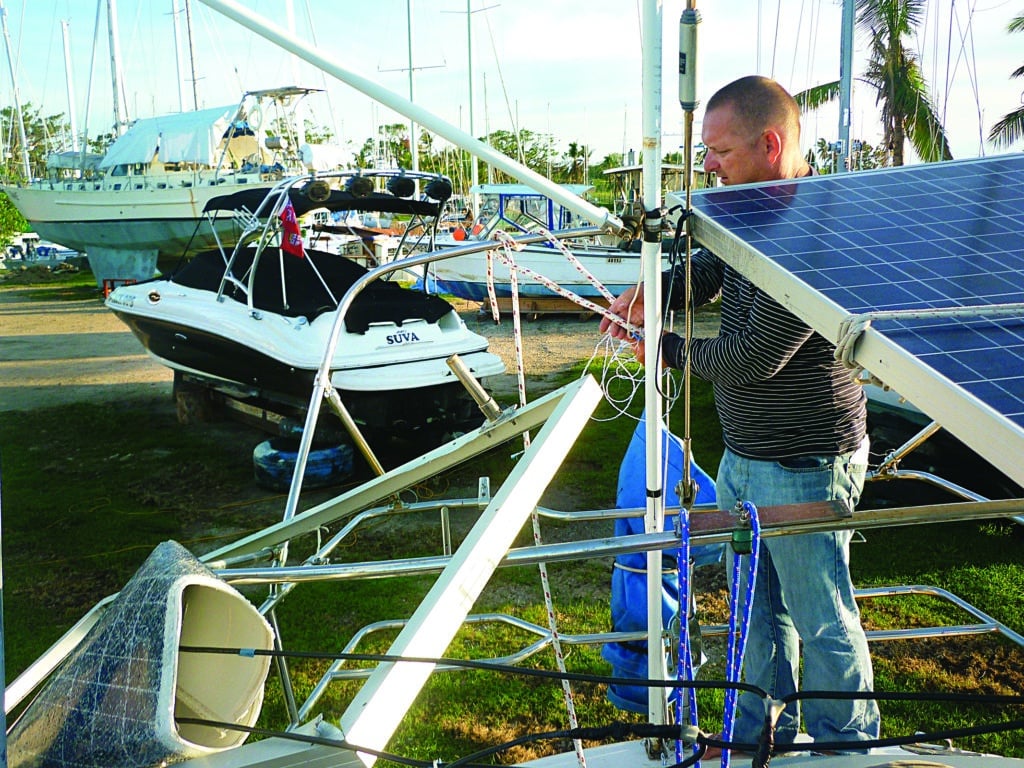
Powering Down
Most cruising boats these days have a suite of solar panels and a wind generator or two to keep up with power demands. These items are not easily replaced in far-flung locales, so it’s best to take proper precautions against damage while you’re away.
The most effective way to prevent damage to solar panels is to simply remove them and stow them below. This is sometimes more easily said than done, however, especially if you’re only leaving for a few weeks. An alternate solution is to custom-cut plywood panels to fit over your solar array and tie them down securely. A 10- to 12-millimeter-thick piece of ply will not only protect your solar panels from flying debris during a storm, but if you’re parked near a palm tree, it will prevent damage from the occasional airborne coconut.
Turning off the wind generator and tying the tail to prevent the unit from spinning is a good idea, but it doesn’t protect the blades from accidental damage. Removing the blades on most models only requires the turn of a nut or two, and takes a couple of minutes. With the blade hub removed, we found the bottom bearing of our wind generator showing signs of rust where water had settled, so now we also wrap the head in plastic to prevent water ingress through the shaft.
Shipping Out
The last thing I do before leaving is wipe down the entire boat with white vinegar. Bulkheads, counters, overheads and soles all get the treatment. This will get rid of any last remnants of salt that linger from everyday movement around the cabin, and unlike using bleach, there are no harsh fumes or chances of ruining surfaces.
With everything cleaned and stowed and the luggage in the cockpit, it’s time to treat the boat for bugs. I don’t use heavy chemical bombs or deadly insect repellent, since after all, we are coming back to live on board. Camphor tablets and mothballs in cupboards and drawers will deter insects and even keep tools rust-free.
With the cabin clean and salt-free, a douse of insect spray and a few traps for cockroaches and ants scattered around the cabin are enough to keep bugs at bay. On the way out, don’t forget to close through-hulls, but be careful not to block those that lead to cockpit drains and bilge discharge!
We usually arrange for the marina, a caretaker or a friend in the area to check on the boat once a week or so. They inspect the bilge, open a hatch if it’s a nice day, and make sure the cockpit and deck drains are free of debris. In case of impending storms, they are there to double-check that everything is secure and to provide updates as we watch the weather from afar. It’s peace of mind worth paying for.
Storing your boat in the tropics requires good planning, a little elbow grease and lots of fresh water, but it all pays off in time. Putting in the hard work before leaving will ensure that when you return in two, four or even six months, you’ll be able to lift the companionway boards and enjoy all the comforts of home without any uninvited guests.
Heather Francis and her Aussie partner, Steve, have been sailing their Newport 41, Kate, full time since 2008. To follow their adventures, visit their website.








